Wednesday, July 23, 2014
Tuesday, July 22, 2014
Monday, July 21, 2014
Thursday, July 17, 2014
18 Green Artists Who Are Making Climate Change And Conservation A Priority
18 Green Artists Who Are Making Climate Change And Conservation A Priority
Katherine Brooks, 07/15/2014 The Huffington Post
"The quality of place, the reaction to immediate contact with earth and growing things that have a fugal relationship with mountains and sky, is essential to the integrity of our existence on this planet," the famous American photographer Ansel Adams wrote in his autobiography. From the romantic painters of the late 18th century to Adams to contemporary figures like Pedro Reyes and Agnes Denes, artists have long had a fascination -- and deep respect -- for the planet on which we exist.
With the words "global warming" and "climate change" never far from the headlines, artists like Adams and co. are more relevant than ever. Tying together the scientific and creative worlds in acts of beauty and activism, sculptors, painters, photographers and more have the power to make environmentalism a priority and bring green initiatives to the forefront of cultural conversations. Behold, 18 green artists who are making climate change and conservation a priority.
1. Olafur Eliasson's Icebergs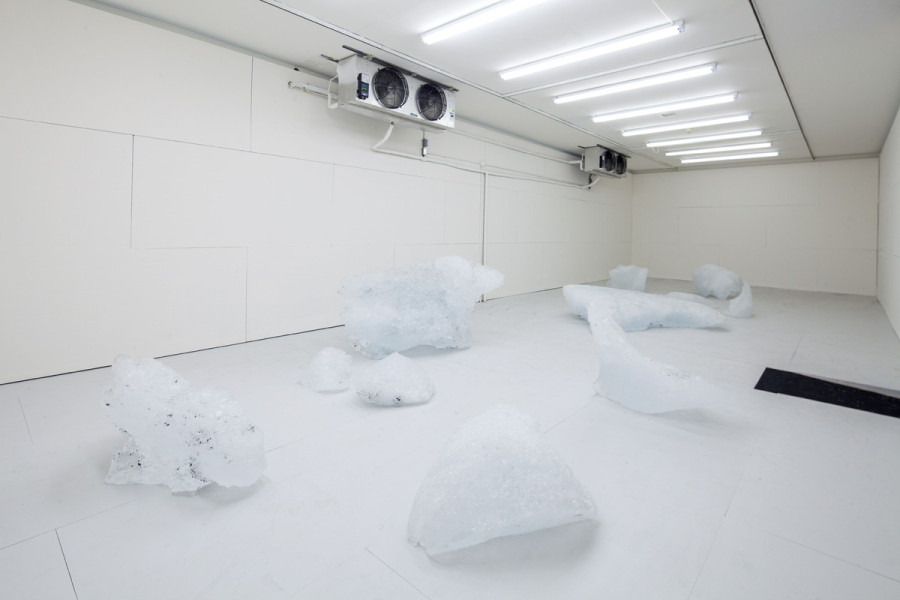

Olafur Eliasson. Your waste of time. 2013. Installation view of EXPO 1: New York at MoMA PS1. Photo: Matthew Septimus.
For "Your waste of time," Olafur Eliasson displayed pieces of ice that broke off from Iceland’s largest glacier, Vatnajökull. Exhibited in a refrigerated gallery space powered by solar panels, the ice "sculptures" represented 800 years of Earthly existence, putting human's physical experience in perspective. "The obvious lesson of Mr. Eliasson’s installation, 'Your waste of time,' is that global warming is wreaking havoc on nature," Ken Johnson wrote in The New York Times last year.
2. David Maisel's Photographs of Open Pit Mines
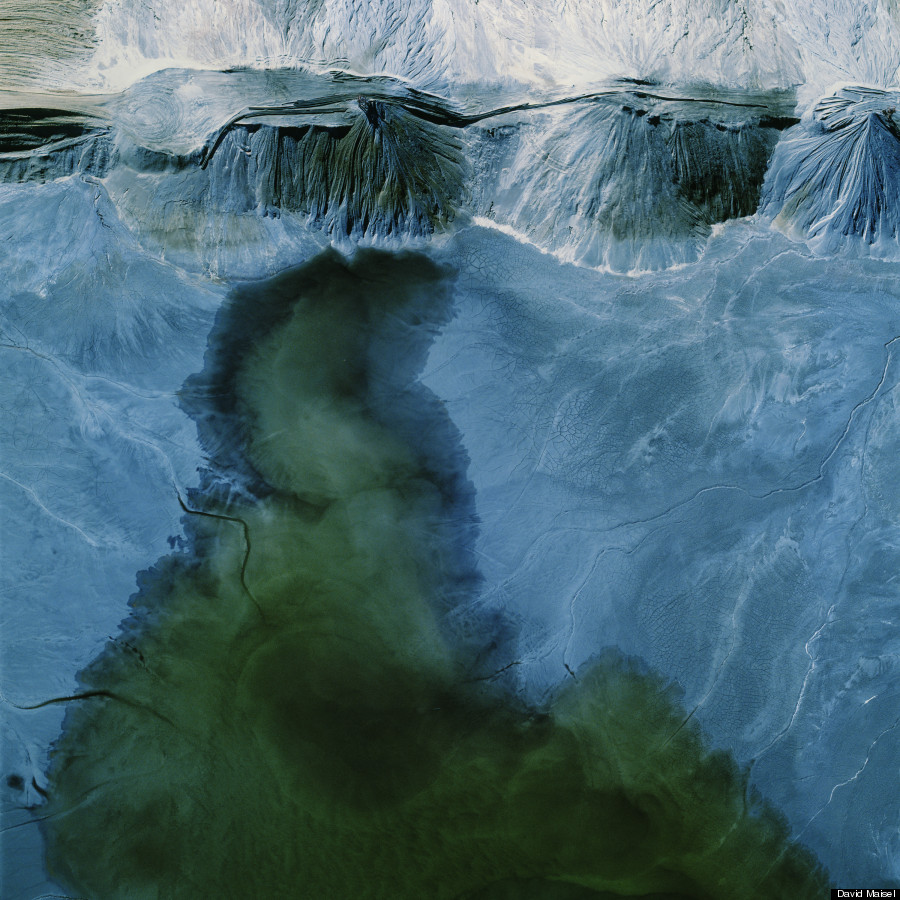
David Maisel, The Mining Project (Butte, Montana 9), 1989, Archival Pigment Print, 2013, 48 x 48 inches, Edition of 5, Courtesy of the artists and Haines Gallery
At first glance, David Maisel's gorgeous photographs seem to celebrate the natural beauty of another planet, but his deep blue swirls and red craters actually depict the aerial appearance of environmentally impacted sites in the United States transformed by water reclamation, logging, military tests and mining. "With the mining sites, I found a subject matter that carried forth my fascination with the undoing of the landscape, in terms of both its formal beauty and its environmental politics," Maisel writes on his website.
3. Luzinterruptus' Waste Labyrinth
The art collective Luzinterruptus has a history of tackling political and social issues in Europe. The "Labyrinth of Plastic Waste" is but one example.
"We were looking to demonstrate, in a poetic manner, the amount of plastic waste that is consumed daily," Luzinterruptus explained in a statement. "In addition to focusing attention on the big business of bottling water, which leads to very serious problems in developing countries, whose citizens have watched as their aquifers have been privatized with impunity for the exclusive enrichment of large business owners and ruling classes without scruples."
4. Amanda Schachter and Alexander Levi's Harvest Dome

Architects Amanda Schachter and Alexander Levi's massive "Harvest Dome 2.0," assembled from 450 umbrellas and 128 bottles, once floated around the inlet of Inwood Hill Park in New York City. Deemed a piece of "performance architecture," the 24 by 18-foot structure further proves the world's garbage can we reused in many unexpected ways.
5. John Sabraw's Toxic Sludge Paintings

Using toxic runoff found in the Ohio River region, artist and professor John Sabraw produces his own DIY pigments -- bold yellows and reds that are sourced from the oxidized sludge of abandoned coal mines. Rather than using imported iron oxide from China to make his paint colors, he taps into the water's heavy metals left over from abandoned coal mines, bringing to light the region's pollution problem in the process.
"The artist, like the scientist, has a crucial role to perform in our society," Sabraw explained to HuffPost. "See things differently, act on this vision, report the failures and successes."
6. Naziha Mestaoui's Virtual Forests

Naziha Mestaoui's "One Beat One Tree" projects virtual forests onto city spaces, blurring the boundaries between the natural world and advancing technology. The digital trees actually grow in rhythm with a person's heartbeat, as viewers can connect to the series via a smart phone sensor. And with each virtual plant, a physical one is grown in regions throughout the world, from Europe and Latin America to Africa and Asia. Since its inception two years ago, the project has already sparked the growth of 13,000 trees.
7. Rachel Sussman's Oldest Things

Photographer Rachel Sussman has been traveling the globe for the past 10 years, searching for the world's oldest living things with camera in tow. From the Mojave Desert to the Australian Outback to Greenland's icy expanses, she captures portraits of organisms capable of lasting for 80,000 years, shining a light on our planet's resilience in the face of human intervention. "Extreme longevity can lull us into a false sense of permanence," Sussman wrote for Brain Pickings. "But being old is not the same as being immortal."
8. Barry Underwood's Electric Landscapes

Headlands (Outcrop)
Combining elements of painting, photography, performance, cinema and land art, Barry Underwood renders environmental issues like light pollution and deforestation in electric splendor."My attempt is to portray environmental issues that are not delivered in a heavy-handed way," Underwood explained to HuffPost. "Rather in a way that draws attention in a pleasing way, then if contemplated could unfold a message of dissidence or a natural discord."
9. Paulo Grangeon's 1,600 Pandas.
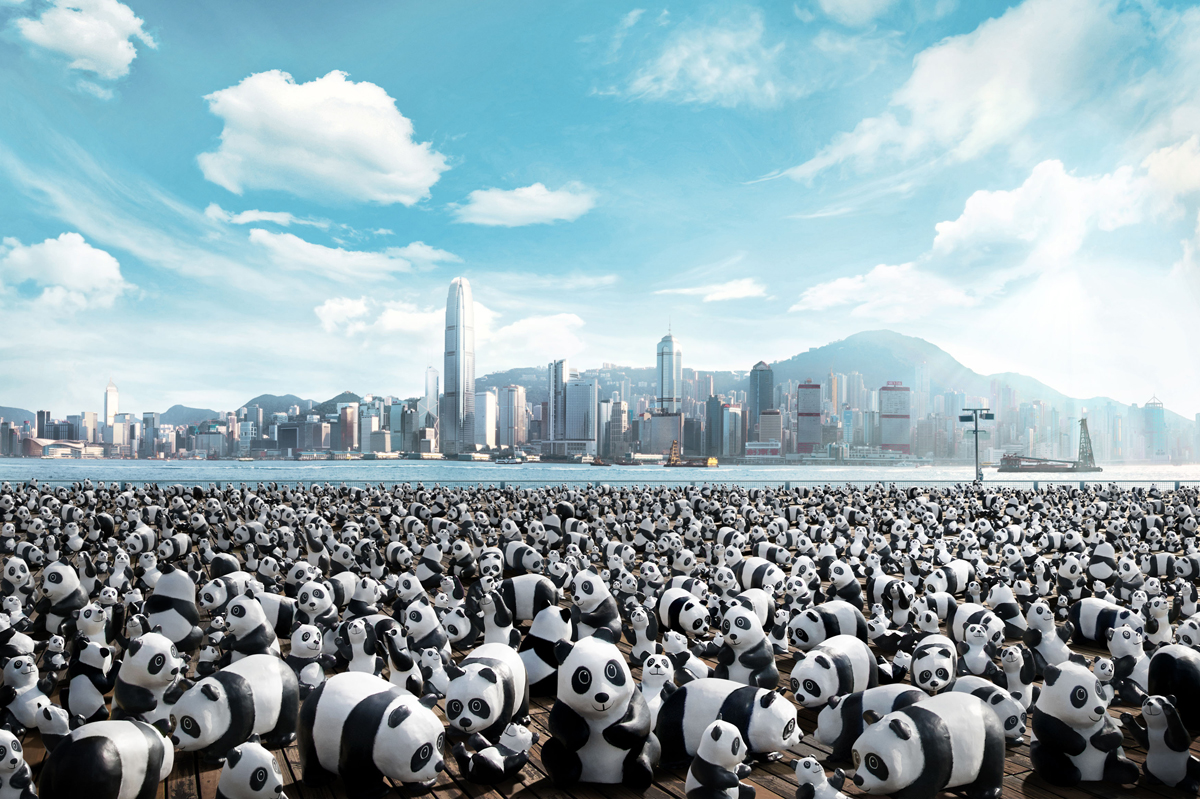
French sculptor Paulo Grangeon used an unlikely medium to illuminate the reality of animal endangerment across the world. For his traveling exhibit, "Pandas on Tour," he created 1,600 papier-mâché bears meant to represent the actual number of pandas left on the planet (recent estimates actually place the number slightly below that, at 1,596). Launched in 2008 in collaboration with the World Wildlife Fund, Grangeon’s project has traveled to landmarks in more than 20 countries, including the Eiffel Tower.
10. Daan Roosegaarde's Vacuum
Ask a Dutch artist to solve the problem of blanket pollution in Beijing and what do you get? If you've tracked down Daan Roosegaarde, you'll get "Smog," a system of underground copper coils meant to suck up airborne particles using an electrostatic field. It's like a vacuum cleaner that operates on a similar principle to statically charged balloons.
11. Aida Sulova's Trash Cans

A Kyrgyz street artist named Aida Sulova confronted the rampant garbage problem in Bishkek by using trash bins as a canvas. According to Wooster Collective, the street artist pastes photographic images of open mouths on garbage cans throughout the city to “remind people that what they throw into the world, eventually ends up inside us."
12. Chris Jordan's Portraits of Consumption

Cell phones #2, Atlanta 2005
Photographer Chris Jordan puts consumption into perspective with his series "Intolerable Beauty: Portraits of American Mass Consumption." His works show the debris we as a society leave behind, from massive dumps of cell phones, to crushed cars and circuit boards, all squeezed together in hypnotic quantities. "I am appalled by these scenes, and yet also drawn into them with awe and fascination," Jordan explained in an email to The Huffington Post. "The immense scale of our consumption can appear desolate, macabre, oddly comical and ironic, and even darkly beautiful; for me its consistent feature is a staggering complexity."
13. Gabriel Orozco's Found Objects
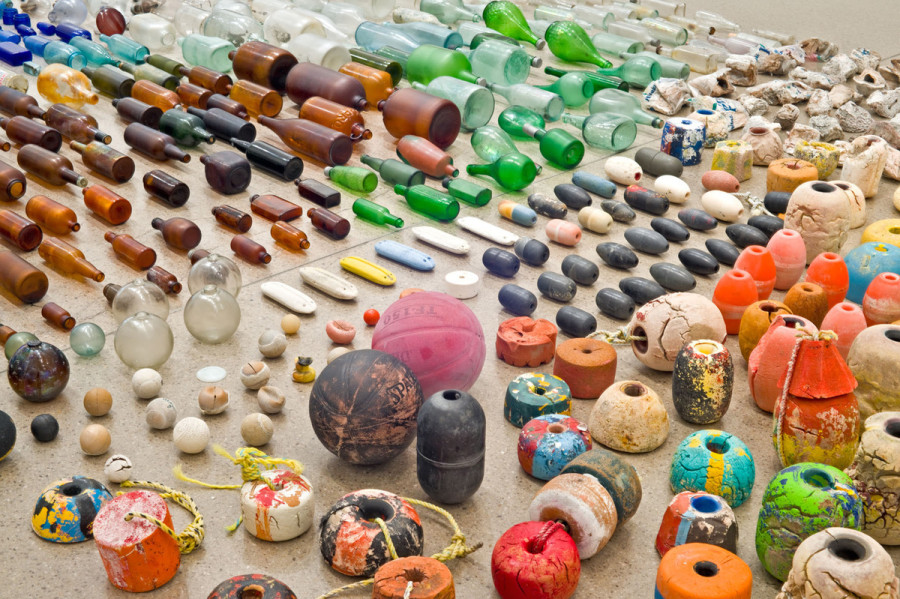
For the 2012 installation "Sandstars," Gabriel Orozco arranged over 1,200 objects from the Isla Arena, Mexico trash repository on the Guggenheim Museum's floor, accompanied by a dozen large, gridded photographs depicting the individual objects in a studio setting. The found treasures bring hints of the ignored wastelands into a gallery setting, forcing viewers to confront the effects of industrial and commercial refuse.
14. rAndom International's Rain Room
The 2013 phenomenon that was the "Rain Room" invited MoMA viewers to experience a deluge of falling water without getting wet. According to the museum's description for the exhibition EXPO 1: New York, "the work invites visitors to explore the roles that science, technology, and human ingenuity can play in stabilizing our environment."
15. Agnes Denes's Wheatfields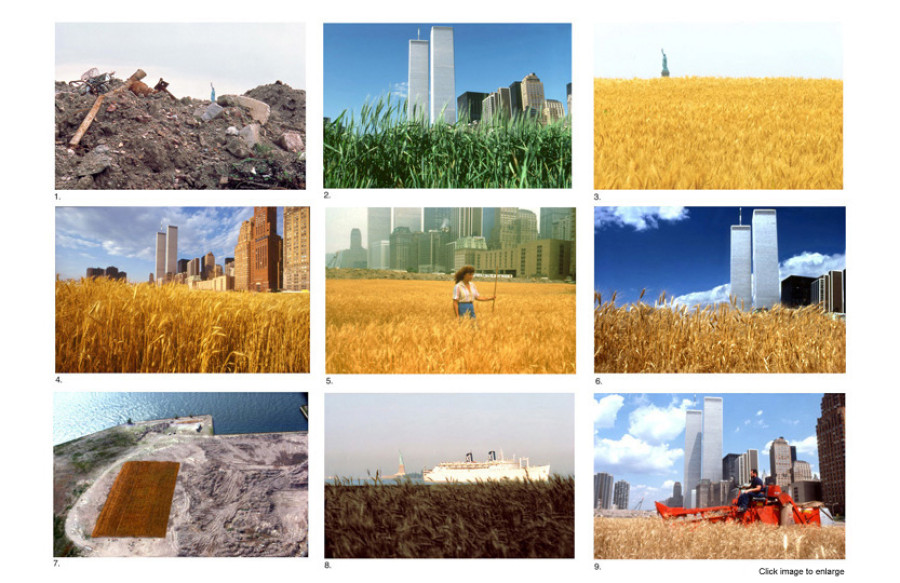

Agnes Denes, Wheatfield, 1982, Courtesy of the artist and Leslie Tonkonow Artworks + Projects
Agnes Denes is a giant among land artists. Her most well-known project is probably the 1982 piece "Wheatfield -- A Confrontation," in which she planted a field of golden wheat on two acres of a landfill near Wall Street and the World Trade Center in Manhattan. She weeded, irrigated and cultivated the mini oasis, bringing the essence of rural America into the throngs of America's urban epicenter. The confrontation was between nature and artifice.
16. Christo and Jeanne-Claude's Surrounded Islands

Christo and the late Jeanne-Claude are well known for their massive land artworks that serve to remind viewers of the natural wonders scattered around the planet. For "Surrounded Islands," the two artists encircled 11 islands in Biscayne Bay, Miami with 6.5 million square feet of floating pink woven polypropylene fabric. In the process, they cleaned up 40 tons of garbage from the floating land masses.
17. Mathilde Roussel's Living Sulptures

French artist Mathilde Roussel created a series of living grass installations that take the shape of human beings. Made of recycled material and fabric filled with soil and wheat grass seeds, the pieces are meant to symbolize the centrality of food. "Observing nature and being aware of what and how we eat makes us more sensitive to food cycles in the world -- of abundance, of famine -- and allows us to be physically, intellectually and spiritually connected to a global reality," the artist explains.
18. Pedro Reyes' Grasshopper Burgers
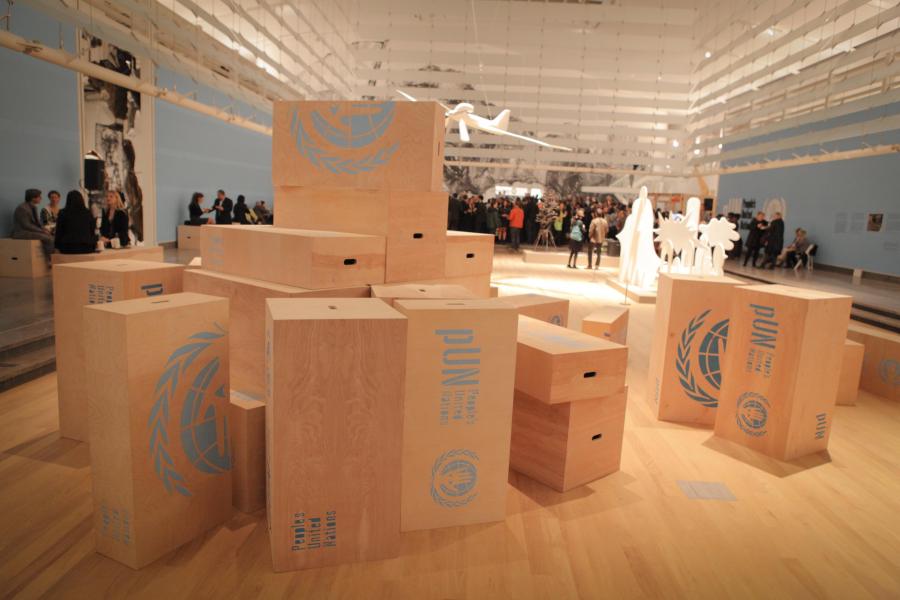
Queens Museum, courtesy Laila Bahman
For "The People's United Nations (pUN)" exhibition at Queens Museum in New York, Mexican artist Pedro Reyes made climate change and geo-engineering points of focus for his diplomatic performance piece. He even served grasshopper burgers during a lunch break to participants in the 193-person assembly to highlight the carbon footprint of meat. "Protein from insects is the way of the future," the artist proclaimed to HuffPost.
Wednesday, July 16, 2014
AGU FM11 - Small climate changes, big ecological impacts
Uploaded on Dec 8, 2011
Press Conference from 2011 AGU Fall Meeting - Thu. 10 a.m. PST
Boreal forests, arctic tundra and other ecosystems can change very quickly -- even if the factor causing the change, such as a warming climate, is itself developing gradually. A slow rise in temperature can cause a complete "regime shift," making the ecosystem suddenly inhospitable for different plant and wildlife species. The potential for regime shifts looms in Alaska's boreal forest, according to new research. One tree species could die off -- and be replaced by grassland, instead of different warmth-tolerant tree species. Wildfires could spark regime shifts as well. Another new study finds that a regime shift 14,000 years ago wiped out one of the largest ecosystems ever, leading to the demise of megafauna like mammoth and wooly rhinoceros.
Boreal forests, arctic tundra and other ecosystems can change very quickly -- even if the factor causing the change, such as a warming climate, is itself developing gradually. A slow rise in temperature can cause a complete "regime shift," making the ecosystem suddenly inhospitable for different plant and wildlife species. The potential for regime shifts looms in Alaska's boreal forest, according to new research. One tree species could die off -- and be replaced by grassland, instead of different warmth-tolerant tree species. Wildfires could spark regime shifts as well. Another new study finds that a regime shift 14,000 years ago wiped out one of the largest ecosystems ever, leading to the demise of megafauna like mammoth and wooly rhinoceros.
Detecting the impact of climate change on plants - Introduction
Published on Apr 6, 2012
On Tuesday 13th March 2012 the National Botanic Gardens hosted an evening of talks by international and national guest speakers exploring the impact that climate change is having on plants and animals.
This event was organised as a collaboration between the National Botanic Gardens, the Environmental Protection Agency, Trinity College Dublin and the National Biodiversity Data Centre as part of Dublin City of Science 2012.
This event was organised as a collaboration between the National Botanic Gardens, the Environmental Protection Agency, Trinity College Dublin and the National Biodiversity Data Centre as part of Dublin City of Science 2012.
Labels:
animals,
plants,
presentation,
scientist,
video
Monday, July 14, 2014
Friday, July 11, 2014
Thursday, July 10, 2014
Wednesday, July 9, 2014
Tuesday, July 8, 2014
Citizens Climate Lobby
Building Momentum with Citizens Climate Lobby from DCErica on Vimeo.
Citizens Climate Lobby’s Introductory call is Wednesday at 5pm Pacific /8pm Eastern. If you have been on this call already, please invite a friend!
The CCL Saturday Education and Action call is the first Saturday of every month at 10:00 AM Pacific, 1:00 PM Eastern (check our home page for changes if this is a US holiday weekend)
The conference line number for both calls is 866.642.1665, pass code 440699#
If 5pm Pacific time doesn't work for you, a recorded version is available at this link:
http://www.citizensclimatelobby.org/calls/CCL-intro-call-sample.mp3
The Community Leaders Project (CLP) team will do the following:
- Request meetings with Community leaders
- Educate the Community leaders on Fee and Dividend legislation
- If the Community Leader is in agreement, invite him/her to go with the local CCL team to meetings with and/or the media Members of Congress
- If requested, leave behind with the Community leader: 1) Video of CCL Conference, 2) The Case for a Carbon Tax and 3) Building the Green Economy.
- Be a part of a recognized CCL lobby team
- Not be the Group Leader or Regional Coordinator
The CLP leader is Mark Tabbert.mtabbert15@gmail.com
CLP calls are the third Monday of the month at 5:00 PM Pacific, 8:00 PM Eastern. The call will last 30-40 minutes. The call in number is 1- 866-642-1665 passcode 440699#.
Sunday, July 6, 2014
Thursday, July 3, 2014
The Climate Pledge of Resistance

The Climate Pledge of Resistance
Diana Bradley, NOVEMBER 13, 2013 beyondtalk.net
The ongoing resistance to climate change has started to assume gigantic proportions. In the latest development, a coalition of faith-based native, societal, ecological and climate groups have created the Climate Pledge of Resistance (CPR) to step beyond talk into action by arranging the biggest ever civil insurrection in their history.
In the 1980s, public sentiment decrying U.S. association with, and sustenance of Central American hostilities took concrete shape as the Pledge of Resistance. This Pledge materialized as a highly effectual national crusade that bolstered independent yet peaceful all-enveloping focused action that embedded itself in simple implicit democracy. Today, this very Pledge has motivated CPR for the Planet.
Propounding this topic, Sharon Lungo, a member of Ruckus Society averred that Climate Chaos was no chimera; it stared them in the face, motivating individuals to step forward to aid in reviving planet Earth from the ill effects of nonstop depredation. Regarding the Pledge, she agreed that all social justice campaigns on record had failed when premeditated employment of peaceful direct action had not been resorted to. Every movement had a focal point for the display of proletariat power, where the crusading community realized that success could only be achieved by forging ahead at full steam. She opined that that focal point had finally dawned.
She firmly believed that peaceful direct action delivered the goods, citing an example in the recent past. A peaceful but large scale civil crusade had been mounted against Mountain Top Removal, which had forced the Environmental Protection Agency to back off and emplace a moratorium thereon. She then emphasized the fact that the Call for CPR for the Planet was launched immediately thereafter.
Tom Goldtooth, Executive Director of the Indigenous Environmental Network, expressed grave concern that extracting and burning fossil fuels amounted to destruction of our planet, affecting every living organism surviving thereon. He felt that growth of fossil fuels had now become a human rights issue, as also ecological justice. Taken together, they affected natives and civilization, not only in the Northern half of America, but also across the universe. He added that it redounded on mankind per se, specifically the ruling hierarchy, to react in real time and move away from an economy dependent on fossil fuels and insist on a practical answer that would defuse the climate change conundrum.
The timing of the Call is also significant:

In the 1980s, public sentiment decrying U.S. association with, and sustenance of Central American hostilities took concrete shape as the Pledge of Resistance. This Pledge materialized as a highly effectual national crusade that bolstered independent yet peaceful all-enveloping focused action that embedded itself in simple implicit democracy. Today, this very Pledge has motivated CPR for the Planet.
Propounding this topic, Sharon Lungo, a member of Ruckus Society averred that Climate Chaos was no chimera; it stared them in the face, motivating individuals to step forward to aid in reviving planet Earth from the ill effects of nonstop depredation. Regarding the Pledge, she agreed that all social justice campaigns on record had failed when premeditated employment of peaceful direct action had not been resorted to. Every movement had a focal point for the display of proletariat power, where the crusading community realized that success could only be achieved by forging ahead at full steam. She opined that that focal point had finally dawned.
She firmly believed that peaceful direct action delivered the goods, citing an example in the recent past. A peaceful but large scale civil crusade had been mounted against Mountain Top Removal, which had forced the Environmental Protection Agency to back off and emplace a moratorium thereon. She then emphasized the fact that the Call for CPR for the Planet was launched immediately thereafter.
Tom Goldtooth, Executive Director of the Indigenous Environmental Network, expressed grave concern that extracting and burning fossil fuels amounted to destruction of our planet, affecting every living organism surviving thereon. He felt that growth of fossil fuels had now become a human rights issue, as also ecological justice. Taken together, they affected natives and civilization, not only in the Northern half of America, but also across the universe. He added that it redounded on mankind per se, specifically the ruling hierarchy, to react in real time and move away from an economy dependent on fossil fuels and insist on a practical answer that would defuse the climate change conundrum.
The timing of the Call is also significant:
- A simultaneous meeting has been scheduled in the city of Pittsburgh, PA for the G-20 as well as the International Coal Conference.
- The Call precedes this pair of meetings by a week.
- Officials are planning a major clampdown in Pittsburgh.
- Two thousand soldiers from the National Guard, fully prepared for any contingency, supplemented by equally large numbers of personnel tasked with law enforcement, will be policing Pittsburgh throughout that period.
- Three Rivers Climate Convergence has not been granted permission to gather and camp there either.

Their intention seems to be to force CPR to resort to civil disobedience in pursuance of their stated objective. It is unlikely that CPR will deviate from a winning strategy, aiming to compel U.S. Senators to consider passing a law that will focus on alleviating the climate change problem.
The strategy is to progressively ensure that the CPR is accepted and fully implemented on November 30, 2009, seven days in advance of the UN Climate Conference in Copenhagen, Denmark, when skilled mediators will bend their brains and thrash out a treaty on climate that can replace the Kyoto Protocol that would have run its course by then.
The Pledge expresses regret that everything is behind schedule. It believes that even if representatives of participating countries reach a consensus now, it would be too weak to be of much use.
True, civil disobedience is nothing new in the U.S. and overseas. Utilized by millions, it was responsible for burying segregation in the U.S., apartheid in its bastion of South Africa, and Independence in India.
The strategy is to progressively ensure that the CPR is accepted and fully implemented on November 30, 2009, seven days in advance of the UN Climate Conference in Copenhagen, Denmark, when skilled mediators will bend their brains and thrash out a treaty on climate that can replace the Kyoto Protocol that would have run its course by then.
The Pledge expresses regret that everything is behind schedule. It believes that even if representatives of participating countries reach a consensus now, it would be too weak to be of much use.
True, civil disobedience is nothing new in the U.S. and overseas. Utilized by millions, it was responsible for burying segregation in the U.S., apartheid in its bastion of South Africa, and Independence in India.
Tuesday, July 1, 2014
Court Blocks Coal Mine Expansion For Not Counting The Costs Of Carbon Pollution

Court Blocks Coal Mine Expansion For Not Counting The Costs Of Carbon Pollution
BY NIDHI THAKAR, JUNE 30, 2014 thinkprogress.org
In a landmark decision on Friday that could have far-reaching implications for federal coal leasing, a U.S. District Court judge ruled against the expansion of Arch Coal’s West Elk mine in Colorado for failure of federal regulators to consider the social cost of carbon in their environmental review.
The decision issued by Judge Jackson of the U.S. District Court in Colorado found that the Bureau of Land Management and the Forest Service overlooked the costs of carbon emissions from the mining and combustion operations associated with the mine’s expansion even though the agencies acknowledged that expanding West Elk’s operations would likely result in greater greenhouse gas emissions.
Friday’s ruling is the result of a challenge brought by environmental groups contesting three agency decisions on the Colorado Roadless Rule and expansion of the West Elk mine in the Sunset Roadless Area. This region is a part of the treasured North Fork Valley backcountry in western Colorado which abuts the iconic West Elk Wilderness and is a destination for hikers and hunters and habitat for the threatened lynx.
The agencies’ decisions would have permitted Arch Coal to expand the West Elk Mine into 1,700 acres of the Sunset Roadless Area, the bulldozing of six miles of road, and the construction almost 50 well pads for the venting of methane from the mine expansion. Methane is a potent greenhouse gas and the second-most prevalent GHG emitted in the United States after carbon dioxide.
According to the decision, the BLM and Forest Service initially found that the social cost of carbon associated with the expansion could be as high as $984 million, but the agencies arbitrarily scrapped this analysis from the final environmental impact statement. However the associated benefits of the project were still included in the agencies’ analysis. The court called this error “more than a mere flyspeck.”
The ruling goes on to acknowledge that agencies are required to analyze the effects of their actions on climate change. The court noted that the BLM and Forest Service “acknowledged that there might be impacts from GHGs in the form of methane emitted from mining operations and from carbon dioxide resulting from combustion of coal produced,” and “this reasonably foreseeable effect must be analyzed.”
The decision was issued just in time before Arch Coal’s exploration activities were set to begin on July 1, and stops the expansion of the West Elk coal mine and any associated surface or below-ground activity, including bulldozing or construction, for now until the parties can agree on how to move forward.
Expanded coal leasing in the American West, particularly the coal-rich Powder River Basin in Wyoming and Montana, has been a hotly contested issue in recent years, with parties raising significant concerns over the climate effects of burning the coal mined in the region.
This court’s decision reminds agencies to consider climate impacts when making decisions affecting federal lands.
There are fewer fish in the sea than ever before

Image: Fishing infographic (c) Global Ocean Commission
Rich countries pay zombie fishing boats US$5 billion a year to plunder the seas
The industrial fleet that now drags the high seas for fish has a combined engine power 10 times stronger than it did in 1950. Its nets are so huge that they’re sometimes big enough to hold 12 jumbo jets. And it is largely thanks to this all-out assault on high-seas fishing stocks that two-thirds of those stocks are at the brink of collapse—or well past the edge.
Without the subsidies, most of these businesses would fail. So thoroughly have industrial fleets overfished the seas that they couldn’t afford the fuel to travel the ever-increasing distance needed to catch the same amount of fish if their governments didn’t lavish public funds upon them.
In economics, you’d call these zombies—unprofitable companies that would fail if governments didn’t prop them up. There are two big problems with zombies. First, they take resources that could go to support new, productive companies. And by subsidizing zombies, governments allow them to keep prices low, driving productive companies out of business.
If industrial fleets weren’t subsidized, they’d go out of business. Small-scale fisheries that don’t need enormous amounts of fuel to catch huge hauls of fish—i.e. the ones using sustainable fishing practices—would then in theory thrive. Many of these fishermen are in poor countries whose governments can’t afford to compete in the industrial looting.
But instead of discouraging this trend, rich countries are paying those vessels to overfish like there’s no tomorrow. Japan, China, the US, the EU and other countries pay $27 billion to subsidize these vessels, according to a report (pdf) by the Global Ocean Commission, an independent body of international leaders focused on ocean conservation policy.
Read the full story on Quartz at http://qz.com/225432/rich-countries-pay-zombie-fishing-boats-5-billion-a-year-to-plunder-the-seas/
Subscribe to:
Posts (Atom)





